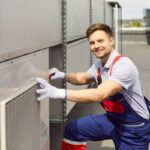In a perfect world, all children would come with an instruction book explaining exactly what they need every day to develop optimal health, learning and communication skills. And – ALL children regardless of economic, physical, emotional and educational disadvantages and challenges would have a caring adult to carry out these instructions.
Despite all their differences – when it comes to building a foundation of strength, balance, endurance and coordination the instructions are quite similar for all children. So, if you are a parent, early childhood teacher or care giver dedicated to providing part of a more perfect world for your children, then I would like to share with you some of the most fun and effective techniques and activities that have been proven to help children achieve optimal motor skills and physical fitness.
As a 30 year veteran early childhood teacher, entertainer and curriculum developer working directly with thousands of 2-5 year old children, it is my intention to provide you with a series of sensible steps they will need to take to acquire superior skills!
All children, regardless of challenges and disadvantages can develop the skills they need to confidently participate in athletic, sports, dance, drama, martial arts and music activities. All they need is the same thing all great athletes, musicians and other performers received in their early childhood – Sensible Steps and Encouragement!
In other words they receive the whole “kit and caboodle.” The steps are the kit and you are the caboodle!
The Body’s Motor System
Just like a finely tuned car, when the body’s motor system is running efficiently and effectively then learning and living becomes more fun, effortless and desirable.
Perhaps the single most important piece of information I have acquired about early learning and motor development is that it doesn’t occur in the brain or body alone. When it comes to learning, thinking, moving and communicating there are THREE parts of the body interactively engaged with these processes – the Brain, Nervous System and the Muscles.
We receive input and information through our senses. We see it, smell it, touch it, hear it and taste it. This input is then processed into knowledge, action or conscious experience through an interaction between the brain, nervous system and muscles. I like to consider this the body’s Motor System.
Research indicates that the three most important processes that get a child’s motor system functioning effectively are Stimulation, Circulation and Connection.
• Stimulation of the whole brain and body
• Connecting the brain to the muscles through the nervous system
• Circulation of blood energy and nutrients throughout the entire body and mind
A steady and balanced flow of these three processes develops the child’s potential for learning, moving and communicating harmoniously and gracefully with their whole body and mind!
Stand and Sit to Keep Kids Fit
One of the first and most effective movement patterns you can encourage 2-5 year old children to keep repeating is to sit and stand a variety of ways. This is the simple activity that turns infants into toddlers. Consistent practice of these activities will build a foundation of core muscle strength, balance and coordination from the hips to the shoulders which will be essential for acquiring exceptional physical skills and abilities.
These activities are also extremely effective for helping children redirect negative behavior. Instead of putting children in “time out,” I have them find a personal space and do these activities to help them calm down and learn to regulate their energies and actions in a more positive manner.
1. Sit and stand several times.
2. Sit and stand with hands on head
3. Stand and shake one foot then the other
4. Stand on one foot then the other for several seconds
5. Stand on toes then heels several times
6. Stand and kneel
7. Stand and squat
Here’s a variety of activities you can encourage your children to do while they are sitting on the floor.
1. Straight and Bend – straighten legs and bend them at the knees several times
2. Apart and Together – with legs straight, move them apart and together several times
3. Put it all together and make them – Straight – Bent – Apart – Together
4. Make one leg straight and one bent, then switch back and forth
5. Bend both legs and move them from side to side
6. Keep both legs straight and move them from side to side
7. Move them in circles from front to side to back to side to front
In my next article I will discuss how music, movement and speech are the three most effective disciplines for helping children achieve balanced and sufficient amounts of stimulation, circulation and connection. Until then practice these sitting and standing exercises with your children as often as possible. The next time they seem restless and bored, or need to refocus and redirect their behavior, have them do these activities to receive the stimulation, circulation and connection that will keep them moving and improving through life!
Scott Liebler 2011
Scott Liebler has been researching, teaching and developing early childhood development programs for the last 30 years. He is the creator of Funsical – http://www.funsical.com – a curriculum of music, movement and language activities that appeal to children’s natural desire to move and have fun while developing essential skills. He is an adjunct faculty member of Front Range Community College in Denver, CO, a seminar presenter for the Bureau of Education and Research (BER) and administers the Move to Improve program for early childhood communities. For information on the Funsical audio CD’s, curriculum materials and training programs please visit http://www.funsical.com or call 800-530-3675.



